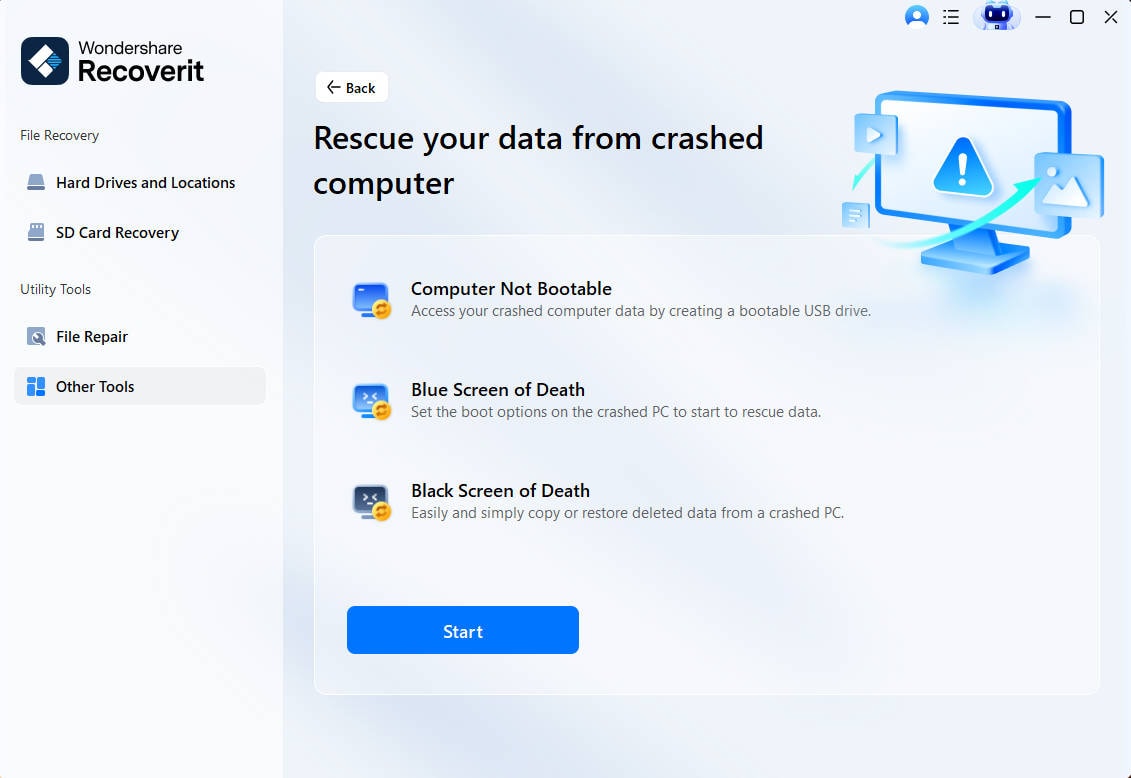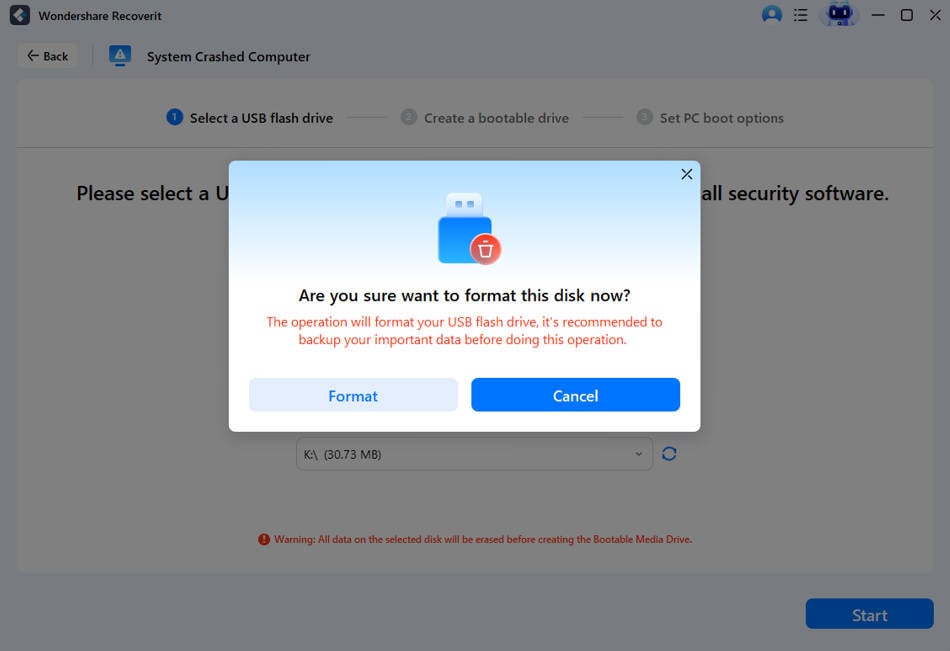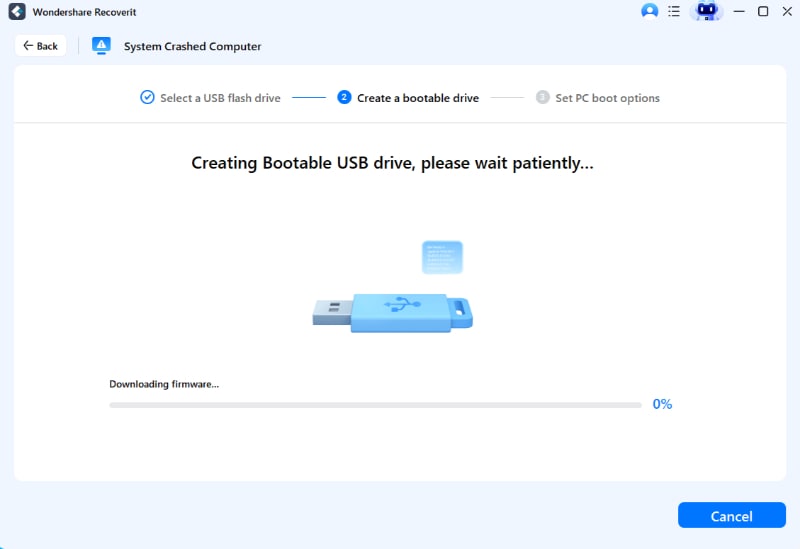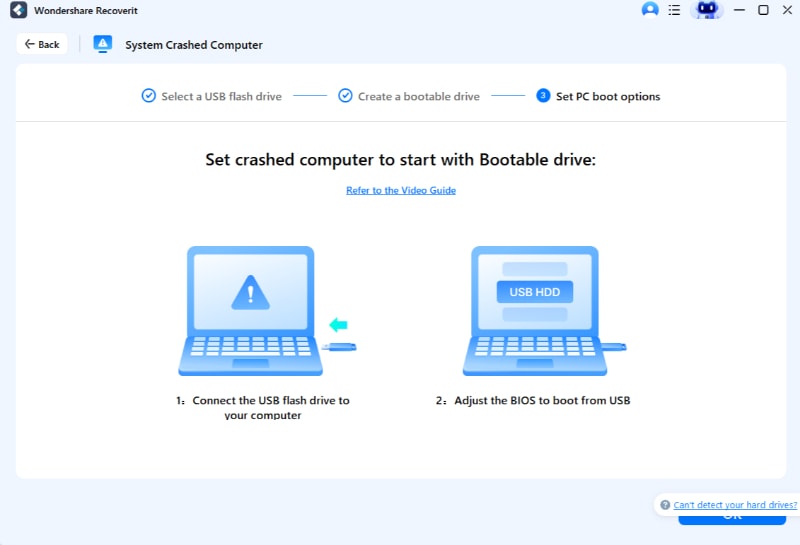The Blue Screen of Death (BSOD) is a frustrating experience for any Windows user. Among the various BSOD errors, the Windows memory management stop code is one of the most common and problematic issues faced by Windows 10 or 11 users.
This error can occur unexpectedly, causing your system to crash and potentially leading to data loss or system instability. If you're encountering the memory management blue screen of death on your Windows 10 PC, don't panic!
In this comprehensive guide, we'll explore the causes of this issue and provide you with effective solutions to help you get your system back up and running smoothly.
In this article
- Fix 1: Restart your PC
- Fix 2: Update Windows 10/11
- Fix 3: Update GPU Driver
- Fix 4: Run the Windows Memory Diagnostic Tool
- Fix 5: Run a Disk Check
- Fix 6: Run the SFC Command to Repair System Files
- Fix 7: Use The Windows Security App to Scan For Viruses Or Malware
- Fix 8: Reset Windows 10 or 11(Last Resort)
Overview of the Memory Management Blue Screen of Death Error
The memory management blue screen of death, commonly referred to as the "memory management stop code" or "Windows stop code memory management," is a critical system error that indicates a problem with the way your computer manages its memory resources.
Resolving this issue is crucial, as it can prevent further system crashes, and data loss, and ensure the stability of your Windows 10/11 operating system.
Here are some of the most common BSOD errors you can encounter on Windows 10 or Windows 11:
| Common BSOD Errors | Overview |
| Blue screen Bccode 50 | Indicates a problem with the Operating System kernel or a kernel mode driver. |
| Blue screen locale id 16393 | Occurs due to a locale ID mismatch between user and system accounts. |
| Stop 0x000000f4 Blue Screen Error | Triggered by a hardware issue, often related to the CPU or memory. |
| Bluescreen 0x000000d1 Error | Represents an issue with the kernel mode drivers managing the Windows kernel resources. |
| Blue Screen 1033 Error | A language or locale setting conflict is causing this stop code error. |
| Blue Screen 0x0000007b Error | Indicates improper shutdown due to a kernel mode driver issue. |
| Blue Screen 0x0000000a Error | Caused by a problem with the kernel mode driver managing memory. |
| Bluescreen code 124 | Related to improper management of virtual memory by a kernel mode driver. |
| Blue screen stop 0x0000003b | System service exception stop code, often hardware or driver related. |
| Blue screen bccode 9f | Indicates a driver verification issue with a kernel mode driver. |
| Blue screen 0x0000001e | Memory management BSOD error related to faulty RAM or drivers. |
| Blue screen bad pool caller 0x00000c2 | Caused by a third-party driver attempting to allocate invalid memory. |
What Causes the memory management blue screen of death?
Understanding the potential causes can help you better troubleshoot and resolve the issue. Here are some common reasons why you may get stuck with the error:
- 💻 Hardware issues: Faulty or incompatible hardware components, such as RAM (Random Access Memory) or a malfunctioning hard drive, can lead to memory management conflicts and BSOD errors.
- 🤖 Driver conflicts: Outdated, corrupted, or incompatible device drivers can cause conflicts with the way your system manages memory, resulting in the memory management BSOD.
- 📌 Software conflicts: Conflicting or incompatible software, including third-party applications or system utilities, can interfere with the memory management process, triggering the BSOD.
- 👾 Malware or virus infections: Malicious software, such as viruses or malware, can corrupt system files or overload memory resources, leading to memory management issues and BSOD errors.
- ❗ Corrupted system files: Damaged or corrupted system files, including those related to memory management, can cause conflicts and trigger the blue screen of death.
How to Fix the Blue Screen of Death Memory Management in Windows 10/11
Now that you have a better understanding of the potential causes, let's dive into the solutions to help you fix the memory management blue screen of death on your Windows 10 system.
This table provides a quick reference to help you identify the potential cause of the memory management BSOD error based on the symptoms you're experiencing and then apply the corresponding fix or fixes mentioned in this section:
| Potential Cause | Applicable Fixes |
| Hardware issues (faulty RAM, hard drive, etc.) | Fix 4: Run the Windows Memory Diagnostic Tool |
| Outdated or conflicting drivers | Fix 2: Update Windows,
Fix 3: Update GPU Drivers. |
| Software conflicts | Fix 7: Use the Windows Security app
Fix 8: Reset Windows |
| Malware or virus infections | Fix 7: Use the Windows Security app
Fix 5: Run a Disk Check. |
| Corrupted system files | Fix 6: Run the SFC Command
Fix 8: Reset Windows |
| Temporary memory conflicts | Fix 1: Restart your PC |
Fix 1: Restart your PC
While it may seem like a simple solution, restarting your computer can sometimes resolve temporary memory management issues. This can help clear any memory conflicts or reset the system's memory management processes. However, if the issue persists after restarting, you'll need to try other solutions.
Fix 2: Update Windows 10/11
Microsoft regularly releases updates for Windows to address various issues, including memory management problems. Ensuring that your system is up-to-date can help resolve the blue screen of death memory management Windows 10/11 error. Here's how:
Step 1: Open the Start menu and click on the Settings icon. Go to "Update & Security" and click on "Windows Update."

Step 2: To upgrade Windows, first hit the "Check for updates" button and install any available updates.
Fix 3: Update GPU Driver
Graphics card drivers play a crucial role in managing graphics memory and can sometimes contribute to memory management issues if they are outdated or corrupted. Updating your GPU drivers to the latest version can help resolve the blue screen of death memory management windows 10 error.
Here's how you can update your GPU drivers:
Step 1: First, press the Windows + R key combination to open the Run dialog box. In the Run box, type "Devmgmt.msc" and hit Enter.

Step 2: In the Device Manager window, expand the "Display Adapters" section. Right-click on the graphic card and select the "Update Driver" option.

Step 3: Follow the on-screen instructions to update the installed GPU driver on your device.
Fix 4: Run the Windows Memory Diagnostic Tool
Windows 10 and 11 include a built-in Memory Diagnostic Tool that can help identify and resolve memory-related issues. This tool can scan your system's RAM for any errors or conflicts that may be causing the memory management BSOD.
Follow these steps:
Step 1: Open the Start menu and search for "Windows Memory Diagnostic." Launch the Windows Memory Diagnostic tool and follow the on-screen instructions to run the diagnostic.

Step 2: If any issues are detected, the tool will provide recommendations for resolving them.
Fix 5: Run a Disk Check
Disk errors or bad sectors on your hard drive can also lead to memory management issues and BSOD errors. Running a disk check can help identify and potentially fix any disk-related problems that might be causing the memory management blue screen of death. Here's how to run a disk check:
Step 1: Open the Start menu and search for "Command Prompt." Right-click on the Command Prompt and select "Run as administrator."
Step 2: In the Command Prompt window, type "chkdsk C: /f /r" (replace "C:" with the drive letter of the disk you want to check) and press Enter.

Step 3: If the drive is in use, you'll be prompted to schedule the disk check on the next restart. Restart your computer, and the disk check will run automatically during the boot process.
The disk check process can take some time, especially if there are errors that need to be fixed. Be patient and let the process complete without interrupting it.
Fix 6: Run the SFC Command to Repair System Files
The System File Checker (SFC) is a built-in utility in Windows that can scan and repair corrupted or missing system files. Since corrupted system files can contribute to memory management issues, running the SFC command can help resolve the blue screen of death memory management Windows 10 error.
Here's how to fix the Windows 10 blue screen memory management using the SFC command:
Step 1: Open the Start menu and search for "Command Prompt." Right-click on the Command Prompt and select "Run as administrator."

Step 2: In the Command Prompt window, type "sfc /scannow" and press Enter.

Step 3: Wait for the scan to complete and follow any on-screen instructions to repair any detected issues.
Fix 7: Use The Windows Security App to Scan For Viruses Or Malware
Malware or virus infections can cause various system issues, including memory management problems and BSOD errors. Running a full system scan with the Windows Security app (formerly known as Windows Defender) can help detect and remove any malicious software that may be causing the blue screen of death Windows 10/11 memory management error.Here's how to perform a scan:
Step 1: Open the Start menu and search for "Windows Security." Launch the Windows Security app and navigate to the "Virus & Threat Protection" section.

Step 2: Click on "Quick scan" to perform a basic scan, or choose "Full scan" for a more comprehensive scan. Follow any on-screen instructions to remove any detected threats.
Fix 8: Reset Windows 10 or 11(Last Resort)
If none of the above solutions work, resetting Windows may be your last resort. This process will reinstall a fresh copy of Windows, potentially resolving any deep-rooted issues causing the memory management BSOD. However, it's important to note that resetting Windows will remove all your installed applications, personal files, and settings. Therefore, it's recommended to back up your important data before proceeding.
Here's how to fix the BSOD Windows 10/11 memory management error by resetting the device:
Step 1: Open the Start menu and go to Settings > Update & Security > Recovery.
Step 2: Under the "Reset this PC" section, click on "Get started." Choose whether to keep your personal files or remove everything.

Step 3: Follow the on-screen instructions to reset your Windows 10 system.
How to Retrieve Lost Data due to Memory Management BSOD Error?
Even if you've lost files and documents due to memory management blue screen of death error, there's still hope. Wondershare Recoverit can help you get back your lost data from your Windows 10/11 computer. This powerful tool can recover data lost due to BSOD errors, accidental deletions, formatting, and more.
Wondershare Recoverit makes it easy to scan your hard drive or storage device and recover your lost files, including documents, photos, videos, and over 1000+ important file formats. The software supports many different file types and has a simple, user-friendly interface, so recovering your data is straightforward.
Moreover, Recoverit is reliable and trustworthy for protecting your privacy and data security. With 20 years of experience, it has a strong track record you can count on.
To use Recoverit and recover your lost data, follow these steps:
Step 1: Install Recoverit Data Recovery software on your Windows 10 system. Launch the program and switch to the "System Crashed Computer" section.

Step 2: The next step is to create a bootable media. Recoverit can help you create bootable media in simple steps. Connect the USB drive to a working system and then hit the "Start" button.

Step 3: Recoverit will now display a prompt on the screen, indicating whether you want to format the drive to create bootable media. Hit the "Format" button.

Step 4: Recoverit will now get to work! It will start the preparation to create a bootable drive.

Step 5: Here comes the final step! Once the bootable media drive is all set, connect it to the crashed PC (One that got hit with the BSOD memory management error). Follow the on-screen instructions to complete the recovery.

Recoverit Data Recovery software is a reliable and effective solution for recovering lost data due to the memory management BSOD error or other data loss scenarios. Its advanced algorithms and user-friendly interface make it a valuable tool for any Windows 10 user.
Tips to Avoid BSOD Errors on Windows 10/11
While the solutions provided in this guide can help you fix the memory management blue screen of death on Windows 10/11 system, it's always better to prevent such errors from occurring in the first place. Here are some tips to help you avoid BSOD errors and maintain a stable system:
- Keep your system updated: Regularly install Windows updates and driver updates to ensure that your system is running the latest software versions and security patches.
- Use compatible hardware and software: Ensure that the hardware components and software applications you use are compatible with your Windows system to avoid conflicts and issues.
- Perform regular maintenance: Regularly scan for and remove unnecessary files, temporary files, and bloatware to free up system resources and optimize system performance.
- Avoid overclocking: While overclocking can provide a performance boost, it can also lead to system instability and BSOD errors if not done properly. Exercise caution when overclocking your system.
- Keep your antivirus software up-to-date: Ensure that your antivirus software is always updated to protect your system from the latest threats that could potentially cause BSOD errors or other issues.
- Use reliable backup solutions: Implement a robust backup strategy to ensure that your important data is safe in case of BSOD errors, system crashes, or other data loss scenarios.
Conclusion
Encountering the memory management blue screen of death on your Windows 10 or 11 system can be a frustrating experience, but it's not an issue without a solution. By understanding the potential causes and following the step-by-step solutions outlined in this guide, you can effectively troubleshoot and resolve the memory management BSOD error.
Additionally, if you've experienced data loss due to the Windows 10 memory management stop code error, Recoverit Data Recovery software can be a valuable tool to help you recover your lost files and documents.
In the event that you encounter any other issues or have additional questions, don't hesitate to seek further assistance from reliable online resources or professional support.
FAQ
What is the memory management blue screen Windows 11 Issue?
The memory management blue screen of death (BSOD) error is a critical system error that occurs when there is a problem with the way your Windows 11 system manages its memory resources. It can display a blue screen with an error message or simply freeze your system.What causes the memory management BSOD error?
Several factors can contribute to this error, including faulty hardware (RAM or hard drive), outdated or conflicting drivers, software conflicts, malware infections, and corrupted system files.How can I fix the memory management BSOD error on Windows 10?
You can try various solutions, such as restarting your PC, updating Windows, running the Windows Memory Diagnostic Tool, updating GPU drivers, running a disk check, using the SFC command to repair system files, scanning for viruses/malware, and resetting Windows as a last resort.


 ChatGPT
ChatGPT
 Perplexity
Perplexity
 Google AI Mode
Google AI Mode
 Grok
Grok























